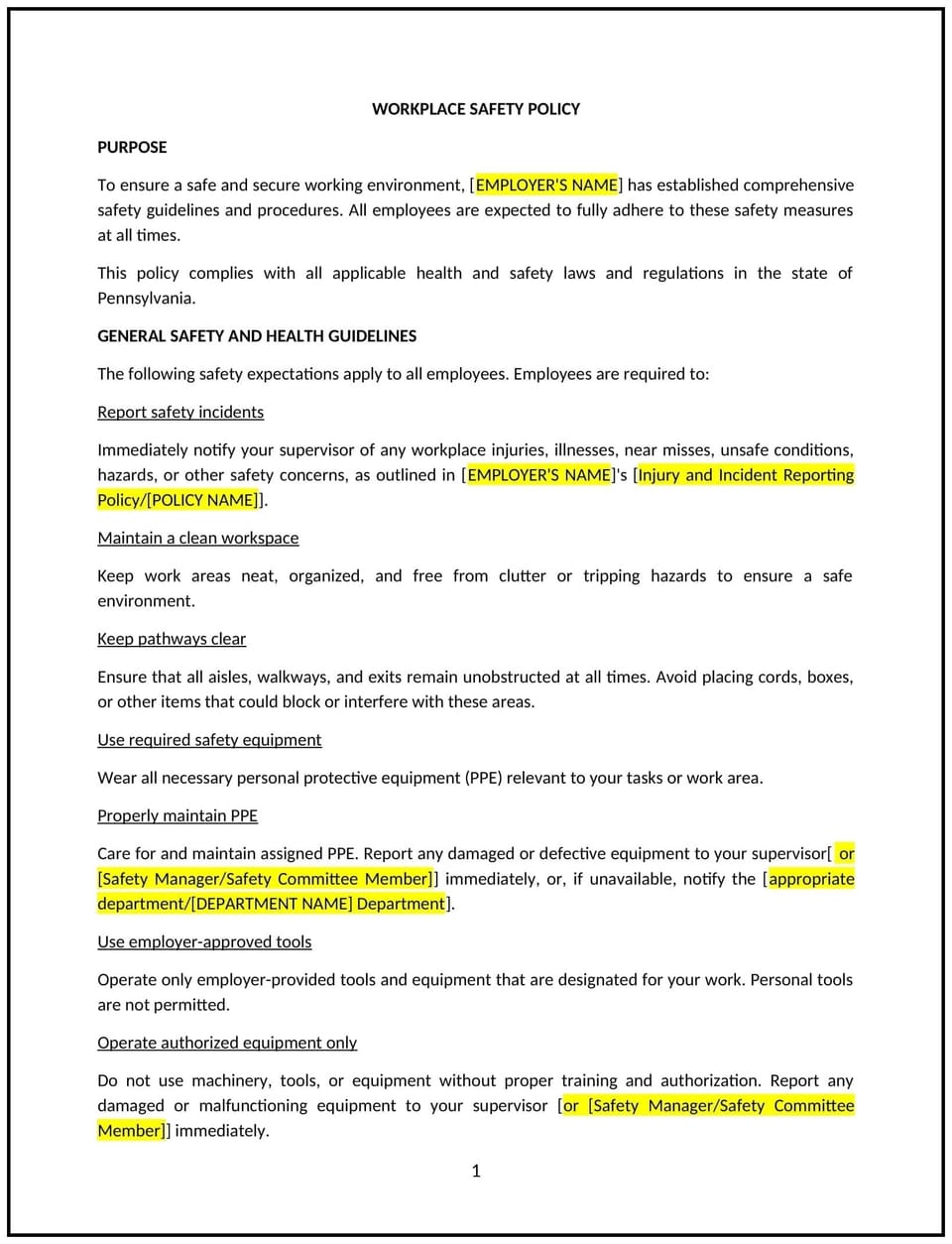Workplace safety policy (Pennsylvania): Free template

Workplace safety policy (Pennsylvania)
This workplace safety policy is designed to help businesses in Pennsylvania establish guidelines to maintain a safe and healthy work environment for all employees. By outlining responsibilities, preventive measures, and reporting procedures, this template helps businesses reduce risks and align with Pennsylvania and federal safety regulations, including OSHA standards.
By using this template, businesses can protect employees, improve compliance, and foster a culture of safety.
How to use this workplace safety policy (Pennsylvania)
- Define safety expectations: Clearly specify safety standards, such as maintaining clean workspaces, using personal protective equipment (PPE), and following emergency protocols.
- Establish roles and responsibilities: Assign safety-related responsibilities to employees, supervisors, and management to ensure accountability.
- Include preventive measures: Provide strategies for hazard identification, regular safety training, and implementing workplace inspections.
- Detail reporting procedures: Outline how employees can report unsafe conditions, accidents, or near-misses, including designated contacts and required documentation.
- Reflect Pennsylvania-specific considerations: Tailor the policy to address industry-specific risks or state safety requirements, such as those relevant to manufacturing or energy sectors.
Benefits of using a workplace safety policy (Pennsylvania)
A well-structured workplace safety policy supports employee protection and operational efficiency. Here's how it helps:
- Promotes employee well-being: Reduces the risk of workplace injuries, illnesses, and accidents.
- Improves compliance: Aligns with Pennsylvania and federal safety regulations, minimizing legal risks and penalties.
- Encourages accountability: Establishes clear expectations for maintaining workplace safety and reporting hazards.
- Enhances workplace morale: Demonstrates the organization’s commitment to employee safety and well-being.
- Reflects local needs: Considers Pennsylvania-specific safety concerns, such as regional industry risks or weather-related hazards.
Tips for using a workplace safety policy (Pennsylvania)
- Communicate the policy: Share the policy with employees during onboarding and ensure it is easily accessible for reference.
- Provide training: Offer regular safety training tailored to the organization’s specific risks and workplace hazards.
- Conduct inspections: Perform routine workplace inspections to identify and address potential hazards.
- Document incidents: Maintain thorough records of workplace accidents, injuries, and corrective actions to ensure accountability.
- Review periodically: Update the policy to reflect changes in Pennsylvania safety laws, workplace practices, or employee needs.
Q: What safety standards are outlined in this policy?
A: The policy includes guidelines for maintaining clean workspaces, using PPE, following emergency procedures, and reporting unsafe conditions.
Q: How can employees report safety concerns?
A: Employees can report safety concerns to their supervisor, HR, or a designated safety officer using the procedures outlined in the policy.
Q: What preventive measures are included in this policy?
A: Preventive measures may include regular safety training, hazard assessments, and workplace inspections to minimize risks.
Q: How does this policy benefit Pennsylvania businesses?
A: The policy helps businesses in Pennsylvania create a safer work environment, improve compliance with safety regulations, and reduce risks associated with workplace incidents.
Q: How is this policy tailored to Pennsylvania-specific needs?
A: The policy reflects Pennsylvania’s unique industry risks, such as those in manufacturing, construction, or energy, and addresses state-specific safety regulations.
This article contains general legal information and does not contain legal advice. Cobrief is not a law firm or a substitute for an attorney or law firm. The law is complex and changes often. For legal advice, please ask a lawyer.


